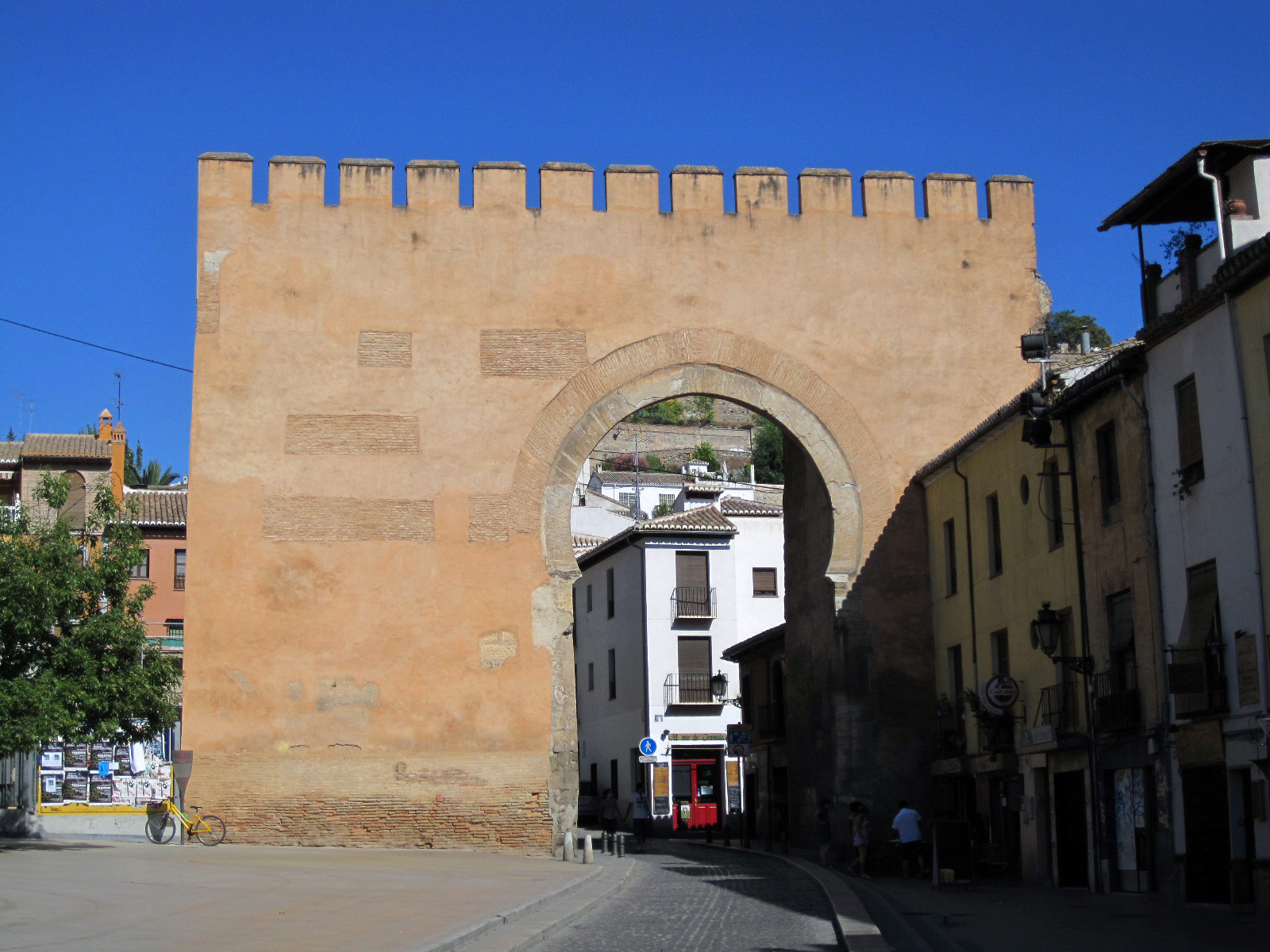 There’s an old Spanish folktale about Roderic, the last Visigoth King of Spain before the Moor Invasion. According to the legend, there was a Secret Tower, hidden from all mankind, secured from entry by 26 secretly made locks. The Tower was created to hold a secret that no-one should ever discover. Unfortunately for the Visigoths, Roderic did find it He found the secret tower, broke all the locks and entered.
There’s an old Spanish folktale about Roderic, the last Visigoth King of Spain before the Moor Invasion. According to the legend, there was a Secret Tower, hidden from all mankind, secured from entry by 26 secretly made locks. The Tower was created to hold a secret that no-one should ever discover. Unfortunately for the Visigoths, Roderic did find it He found the secret tower, broke all the locks and entered.
Painted along the interior walls he saw a mural of strange men dressed in eastern robes, mounted on ferocious horses, brandishing bloody swords and riding into battle. In the center of the tower was a table that belonged to King Solomon. On top of the table, an urn held an ancient scroll. Roderic broke the urn and unraveled the scroll. It read “if this Tower is violated, the figures on the wall will come to life and slay all those who have committed the violation.”
And so, in 710, Tarif abu Zura a Berber chief crossed the straits of Gibraltar. His forces killed King Roderic. Most of Visigoths either died in battle or deserted the flight and fled. The Moorish conquest of Spain had begun.
There were four Moorish Dynasties in Spain between the years of 710 and 1492.
The Umayyad Caliphate (715-1040) were mainly Arab from the exiled Umayyad family of Damascus. Cordoba was their Capital city. The Umayyad city of Cordoba still exists. The 10th century Great Mosque of Cordoba is a “must visit” for anyone interested in Moorish Spain, or anyone interested in a great destination.
The second Dynasty was the Almoravid (1085-1147) and the third dynasty was the Almohad (1147-1238) The Almohavid and Almohad, dark skin Berbers from North Africa extended the Moorish empire into Sicily. The word Berber comes from the roman word “barbari” barbarian. Everyone outside of the Roman colonization were called Barbari.
The main city of the Almohad was Seville.
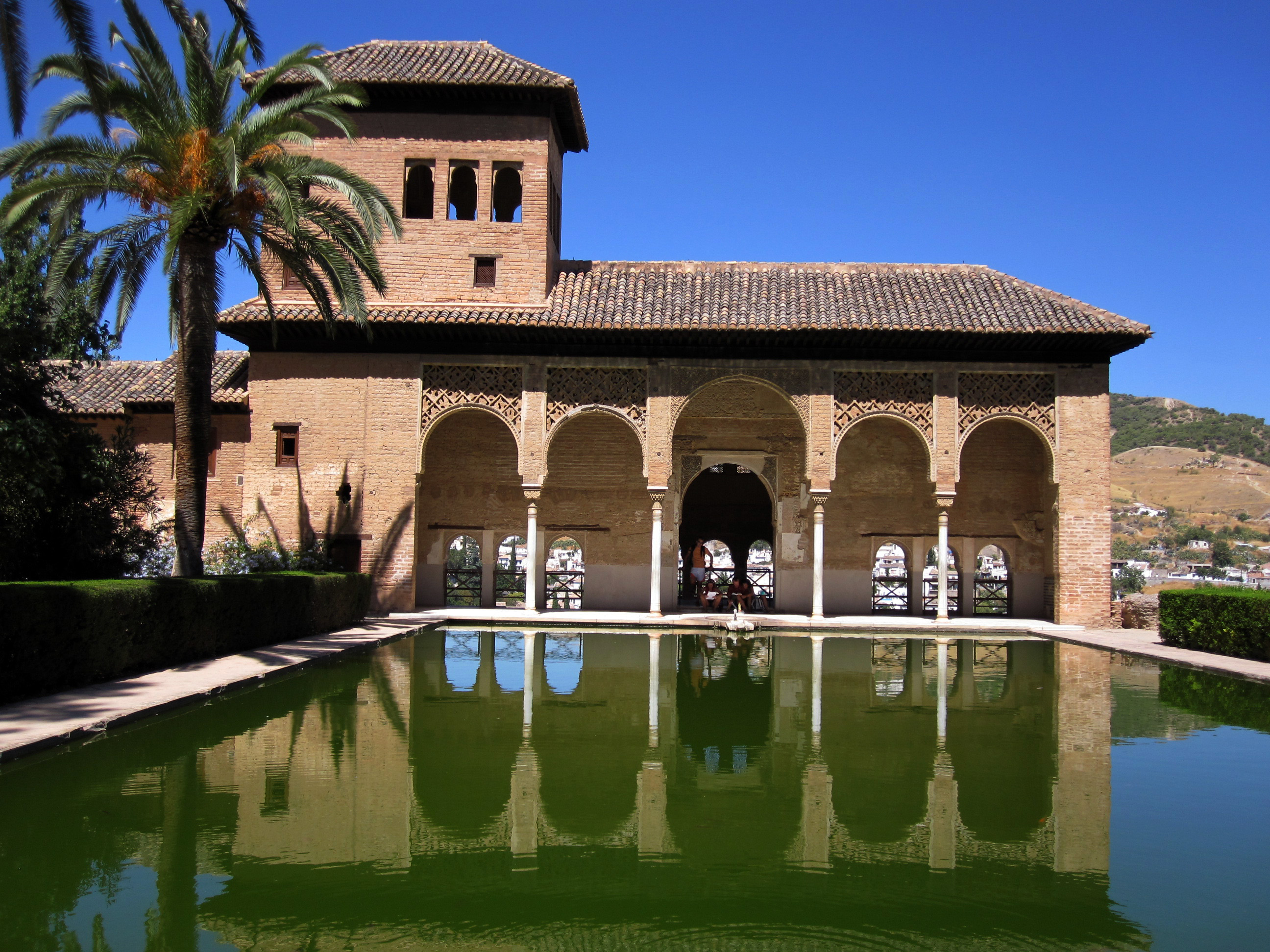
In 1212 a large Spanish and Portuguese Christian army defeated the Almohad Moors at the battle of Las Nava de Tolosa, near Jaen. Over 10,000 soldiers died in the battle. This marked the end of the Almohad and the beginning of the Nasrid, the last Moorish Dynasty.
The Nasrid ruled the remains of Moorish Spain from Granada between 1238 and 1492.
On January 2, 1492, after 782 years in Spain, the Nasrid Caliph Mohammed XII, known as Boadbil, surrendered to King Ferdinand and Queen Isabella and the Kingdoms of Aragon and Castile. According to legend, after Boabdil lost the city he went to his mother and burst into tears. He mother comforted him by saying, “you do well to weep like a woman over what you could not defend like a man.
”This was the end of the Moors. The gate they walked through at the Alhambra was sealed up in a symbolic gesture that the Moors would never return again. The Spanis Kings kept their armies large and constantly prepared for the return, but they never came. Even today the Spanish use the expression “no hay moros en la costa” (literally, “There are no Moors on the coast”), the coast is clear.
The Moors did come back, although these days they just call themselves Muslim. There are about 200 mosques in Spain today, 50 of them in the Andalucia region alone. Of course, at one time, there were over 1600 mosques in Cordoba alone.
GRANADA
We’re relaxing in a 15th century Convent (converted into the beautiful AC Palacio Santa Paula in 2000). Our room looks over the old cloisters. It peaceful and very quiet, well it’s quiet until the dinner hours when the very amplified samba music reverberates through the cloisters. Cloisters were designed so that the sounds of breathing could be heard as a meditations. The musicians really didn’t need the amplification but then they probably didn’t want to hear the people dining. When you mix music and food, it’s sometimes difficult to tell which is more important. But when we closed the wooden shutters on the windows, the room was pitch black, quiet and cool as could be.
The hotel is in the old city, a short walk to the (super large Spanish Gothic) Cathedral, the old Medina and the ancient winding alleys of the Albaysin neighborhood. The word Albaysin means the basins (al baysin). When it was named by the Nasrids, there were 6 streams running under the area. The water never stopped flowing through the fountains. The Albaysin is an ancient webwork of inlaid river stone streets up a fairly steep hill.You can barely fit 2 people across on these small streets. If you decide to live in the Albaysin, you lear to do a lot of walking.
Towards the bottom of the hill, close to the Via Grand Colon are the tourist (Moroccan knickknacks) shops that sprawl along the Via Elvira, one of the main streets of the old Albaysin. The Moorish gate at the top of the page is the Elvira Gate that led into the old Moorish city.
Via Elvira is a narrow street. It’s not a good place to drive a car (as we found out when we were looking for the parking garage), but it’s a great place for a delicious and authentic Moroccan meal. On our first night here we dined at the Restaurante Arrayanes . This restaurant has been written up by everyone from the San Francisco Chronicle to the National Geographic to Rick Steves. At first we were afraid. With all these recommendations, we thought the place would be filled with loud tourists. We went to check it out anyway and we are so glad we did. Yes, it was filled with tourists (mostly English speaking), but everything from the mint lemonade to the cumin scented humus, the sweet babaganoosh, the almond, pistachio and chicken stuffed pastelle and the lamb kebobs were unbelievable good. We’ve eaten Moroccan food before but it never tasted like this. Two nights later, we were back again; this time with the German tourists. We proudly add our names to all the others who have given praise to Restaurant Arrayanes in Granada.
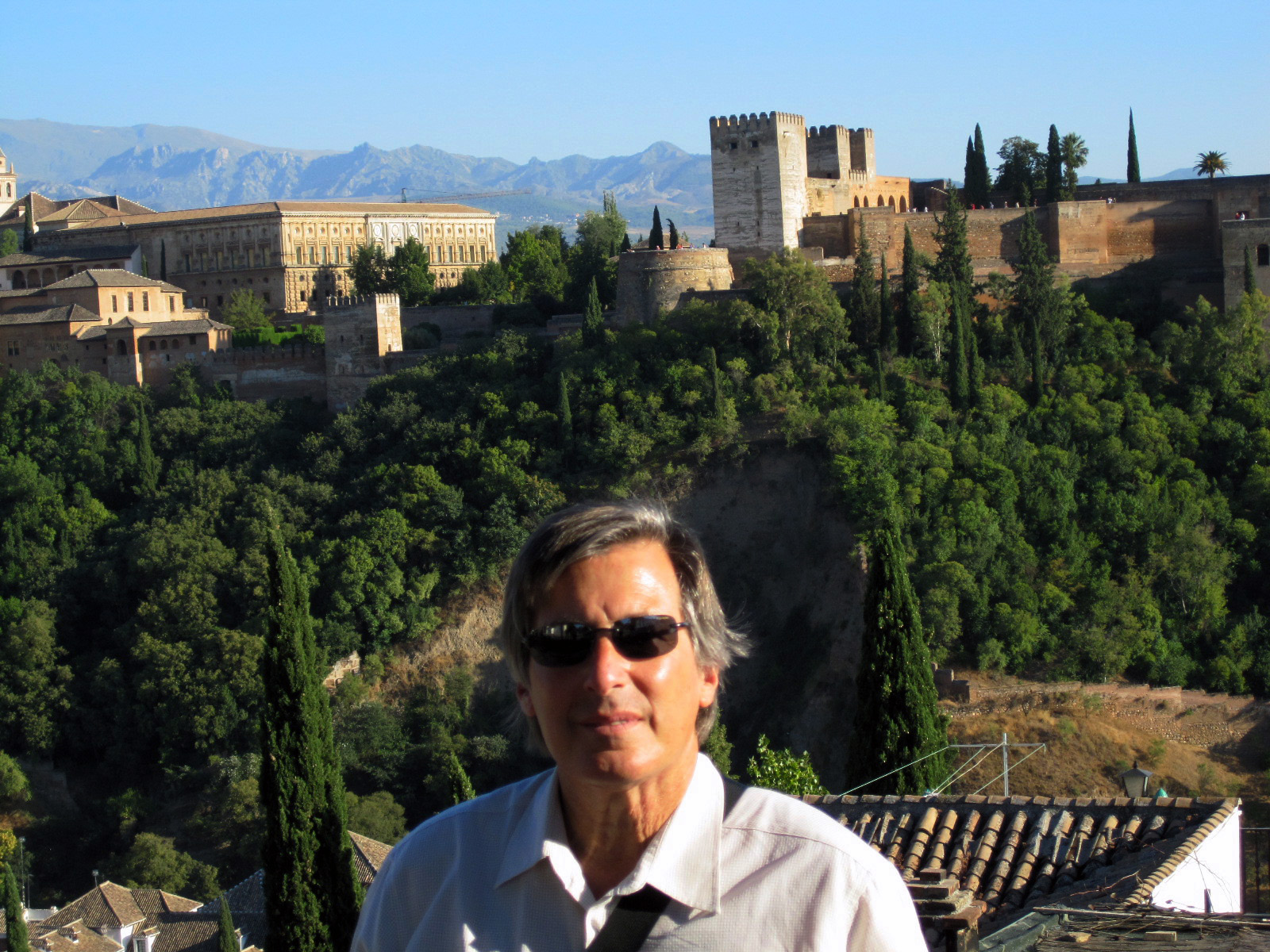 Although the Moors first arrived in Spain in 710, Granada’s glory years were from 1238 till 1492. The Alhambra (or red citadel) was mostly built during the reign of the Nasrid Caliph, Mohammed V (1338-1391).
Although the Moors first arrived in Spain in 710, Granada’s glory years were from 1238 till 1492. The Alhambra (or red citadel) was mostly built during the reign of the Nasrid Caliph, Mohammed V (1338-1391).
The Alhambra Palace, The Alcazaba Fortress and the Generalife gardens and summer palace are all up on the hill overlooking the city. It’s a good climb to get up there but the reward is worth it.
Much of it has been rebuilt but it is a lovingly detailed restoration and you can definitely feel the peace and tranquility of life on the hill overlooking Granada.
The Alcazaba fortress is the oldest part of the complex. The walls and towers are still visible but the interior has been stripped down to the foundations. This was once the main point of defense and still has some an amazing view over the Vega (the Granada plains). That’s the Alcazar fortress behind me.
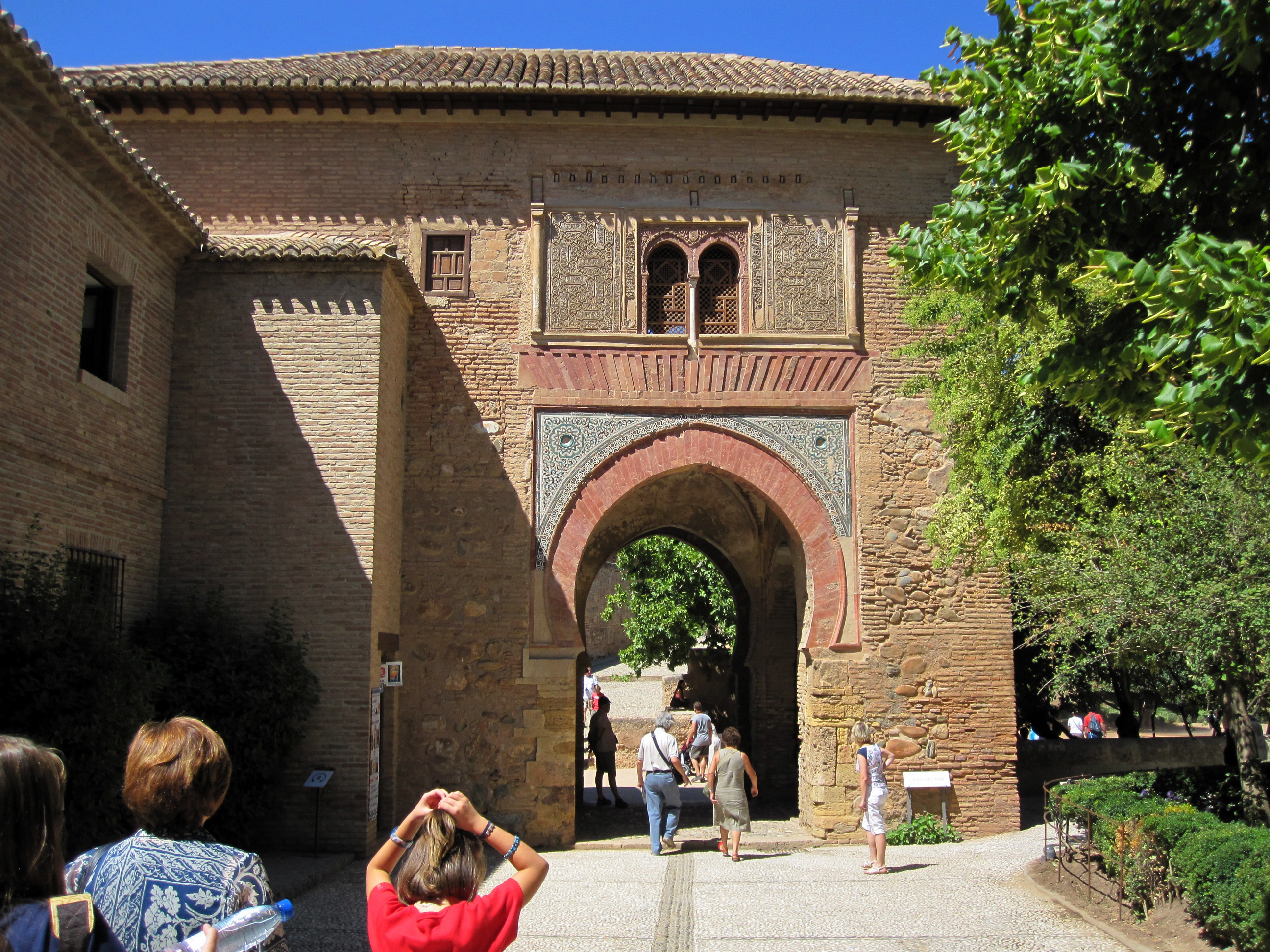
At the main entrance to the Alhambra is the Puerta del Vino (the place where, supposedly, wine was once given out to the people of Granada for free, but probably not every day).
According to Washington Irving, who lived here in the early 1800’s, beneath the keystone inscription of a key and the hand of Fatima lies the mystical kingdom of the magician/astrologer Ibrahim Ibn Abu Ayub.
If you sit under the main arch for a few minutes on a very quiet day you can sometimes hear the enchanted sound of the silver lyre and faint voice of the beautiful princess the magician tricked away from the Caliph Aben Habuz.
According to the legend, when the Fatima hand touches key, the ground will open and reveal the beautiful princess, the magician and the massive treasure of the ancient Moors. It’s a great story but it’s never a quiet day at the main gate. There are always too many tourists.
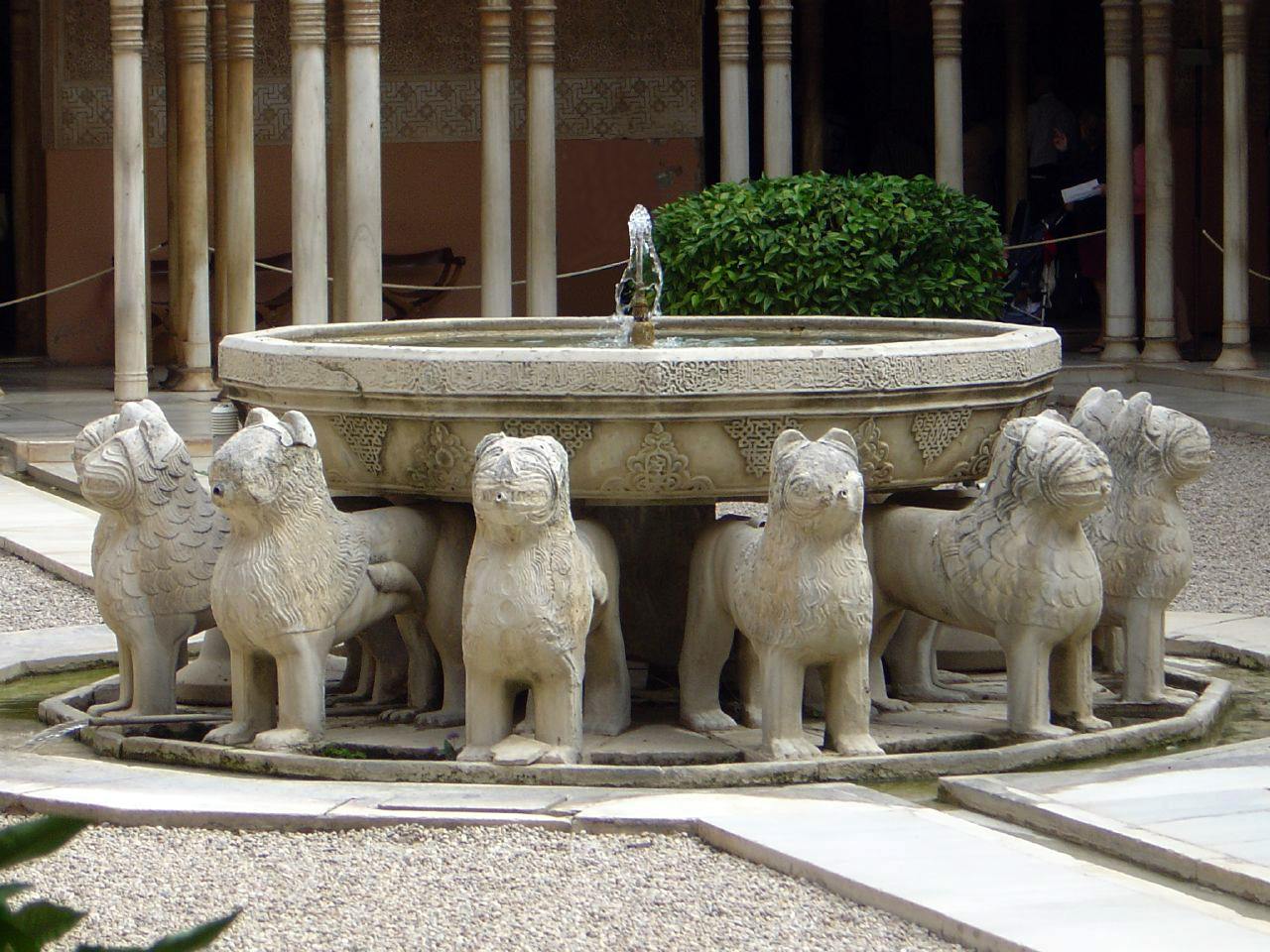 One of the most famous and well preserved patios of the old Alhambra is the “Court of the Lions”, a beautiful 116’ long by 66’ wide courtyard supported by 124 white marble columns. The alabaster fountain of the lions was commissioned by Muhammad V around 1362. It’s supposedly copied from an old testament description of the fountain in the Temple of Solomon.
One of the most famous and well preserved patios of the old Alhambra is the “Court of the Lions”, a beautiful 116’ long by 66’ wide courtyard supported by 124 white marble columns. The alabaster fountain of the lions was commissioned by Muhammad V around 1362. It’s supposedly copied from an old testament description of the fountain in the Temple of Solomon.
According to Washington Irving, the fountain is a mess of found objects. He said the lions appear to be reused from other locations and that the alabaster bowl was carved by lesser quality craftsmen, maybe prisoners. But regardless of what he thought back then, the Lion Fountain is now one of the symbols of the Alhambra. We never thought of it before but the lions work backwards. They take the water in through their butts and push it out through their mouths. Interesting..
Off the Lion court is the Sala de los Abencerrajes (Hall of the Abencerrages), named after a family of political rivals of Boabdil. As the legend goes, one of the Abencerrages clan climbed into one of the royal windows in his romantic quest of one of Boabdil’s daughters. Boabdil remained clam for the moment and acted as if he knew nothing about the affair. Instead, he invited all 36 members of the family to the Palace for a grand dinner party. After the meal, he put them into this hall and cut off their heads. It’s been said to many tourists who enter the Salon that the red color on the stucco is the remains of the blood from the slaughter. It can’t be cleaned. The stories of Boabdil are many and cruel, from locking his Queen in a tower on for the rest of her life on trumped up charges of infidelity to killing his sister and her two children in a fit of anger. They might be true or they might just add to the resentment of the Moors towards Boabdil for losing the Kingdom.
The Alhambra Place is divided up into living quarters and halls of courtly business, not unlike any medieval palace. We were able to get into the sleeping rooms renovated during the possession of Holy Roman Emperor and King of Spain, Carlos V but many of the other rooms were closed to the public. It’s one more reason to keep going back, just to possibly get a chance to visit the 75′ domed Hall of the Ambassadors. This was the place where Columbus received the financial support of Isabel and Ferdinand to sail to the new world. Columbus was also present when Boabdil gave over the city to Ferdinand and Isabella. The Hall was opened when we were here in 1994, but that was a long time ago. I’m sure there has been a lot of restoration in the past 15 years.
While the rest of western Europe was going through what has been labeled the “Dark Ages”, the Moors were having one of the most enlightened periods in all of Islam. The gardens, fountains and pools of the Alhambra show just a few of their achievements in architecture and irrigation. A 9th century Moors invented the parachute and hang glider. The 11th century Muslims discovered the existence of parasites and created medical cures and advances in surgery. They discovered over 300 new species of plants and drugs. The first autopsies and dissections were in 12th century Moorish Spain. The first use of anesthetic derived from cannabis and opium came around the same time. In the 9th century Moors developed the daily meal claiming that a meal should be three courses, soup, main course and dessert. They gave us the guitar, the first windmills, waste containers for litter collection and streetlamps. They even created toothpaste. Their reign in Spain was one of the most enlightened periods of western history. Maybe that’s why the Christian period that followed is often referred to as the “Dark Ages”.
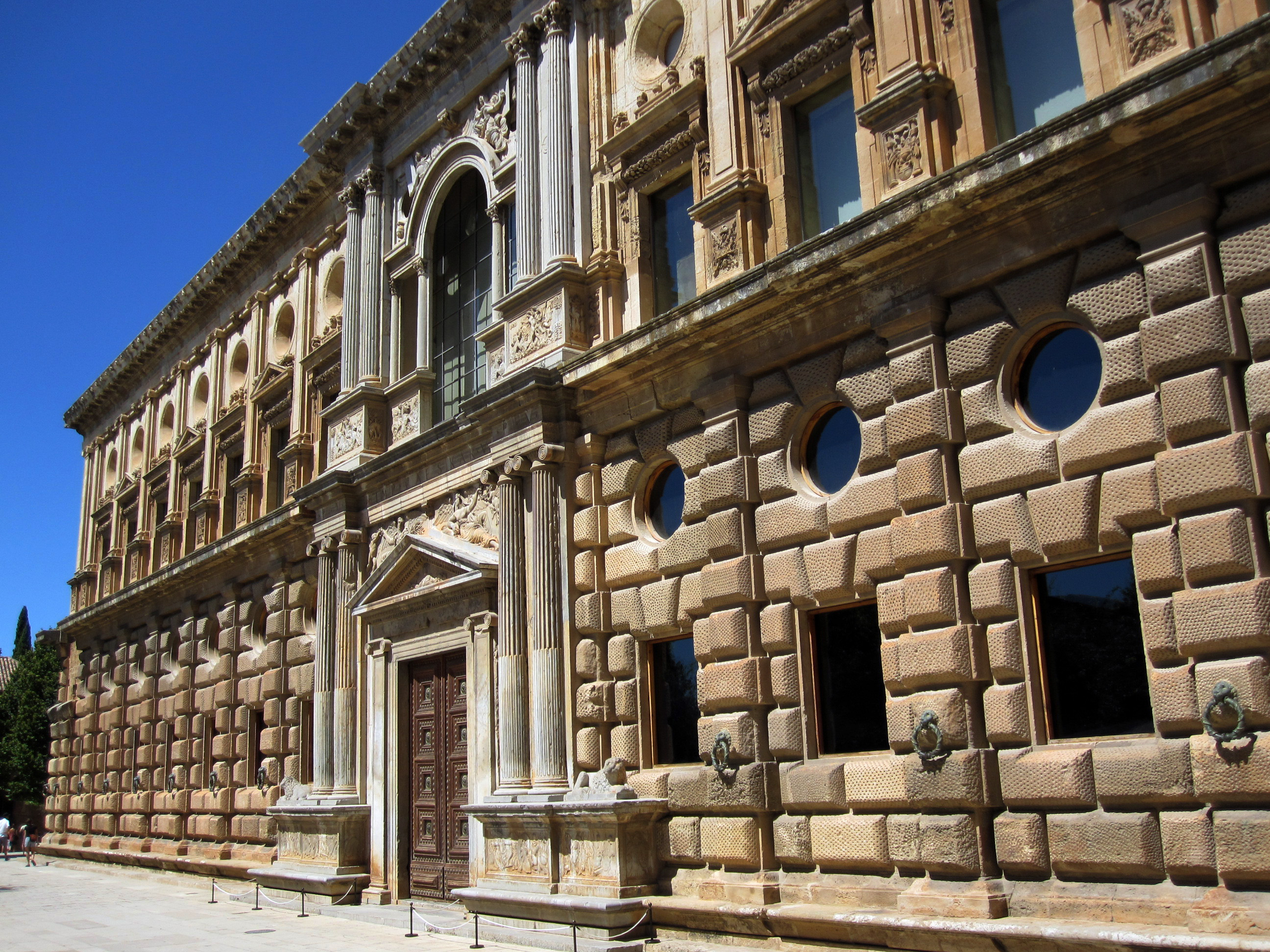 In 1527, the Alhambra became the residence of The Holy Roman Emperor Carlo V (Charles V of Spain), one of the famous long chin Hapsburg clan. As he took residence of the Palace, he stood on the balcony off the Hall of the Ambassadors and exclaimed “what bad fate for a man to lose something this beautiful”. He loved the old Moorish Palace, but Charles had just married Isabella of Portugal who wanted a more contemporary Palace. He decided to build the new Palace inside of the Alhambra complex.
In 1527, the Alhambra became the residence of The Holy Roman Emperor Carlo V (Charles V of Spain), one of the famous long chin Hapsburg clan. As he took residence of the Palace, he stood on the balcony off the Hall of the Ambassadors and exclaimed “what bad fate for a man to lose something this beautiful”. He loved the old Moorish Palace, but Charles had just married Isabella of Portugal who wanted a more contemporary Palace. He decided to build the new Palace inside of the Alhambra complex.
The architecture of his Palace is 16th century mannerist in style and has nothing to do with the Moorish style of the 13th century, but then neither did Carlos V.
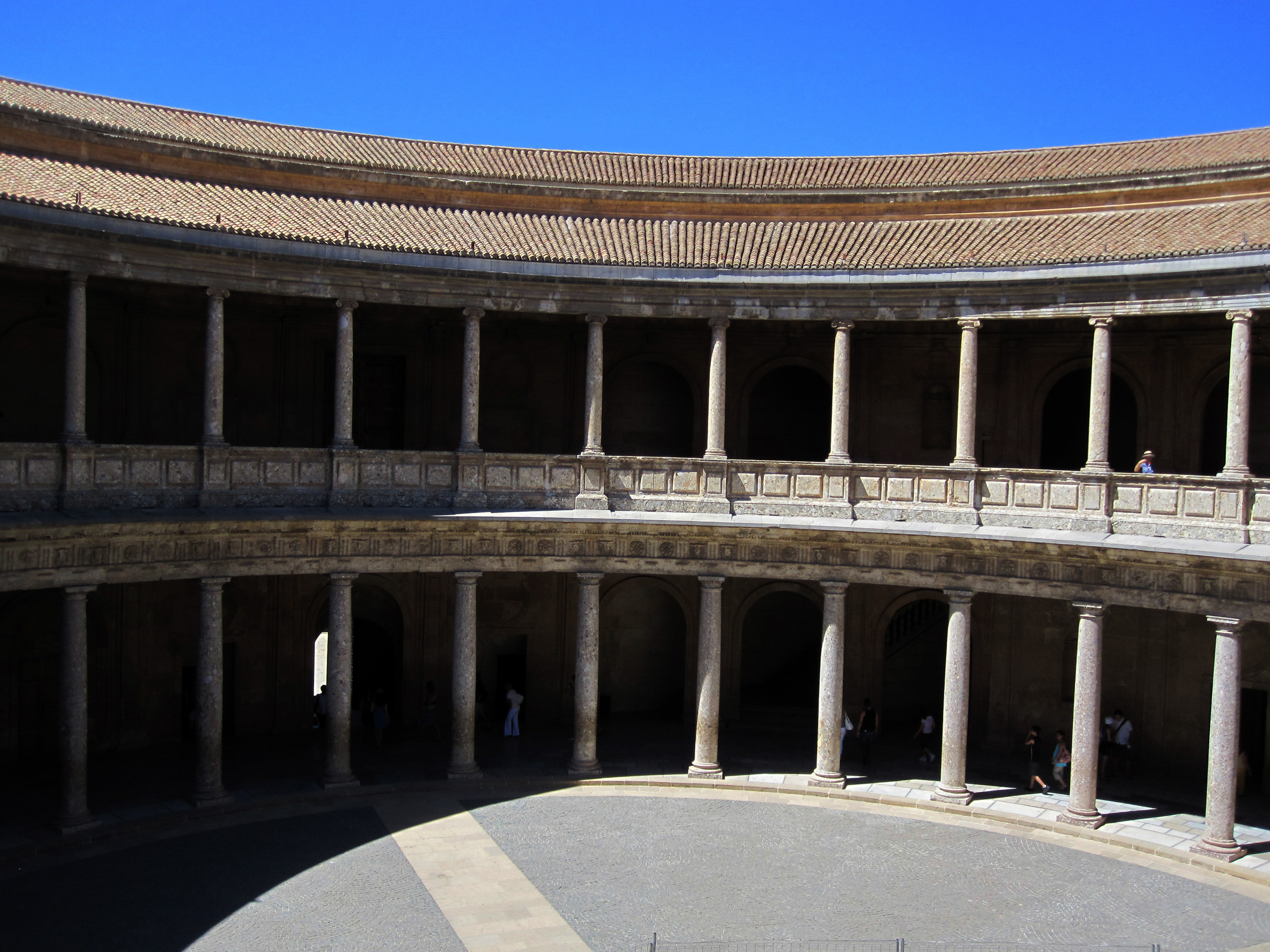 The concept of the Palace of Charles V is a bit weird but kind of interesting. It’s a square building on the outside and a circular building on the inside. It was never completed though.
The concept of the Palace of Charles V is a bit weird but kind of interesting. It’s a square building on the outside and a circular building on the inside. It was never completed though.
Six years after it was started it stopped. Carlos hated it. In fact it’s never been completed. In the 1920’s it was used for mock bullfights and Flamenco dance recitals. It kind of looks like a small Plaza de Toros inside. Anyway, the Place of Carlos V is now another part of The Alhambra’s history. It still looks like it doesn’t belong there.
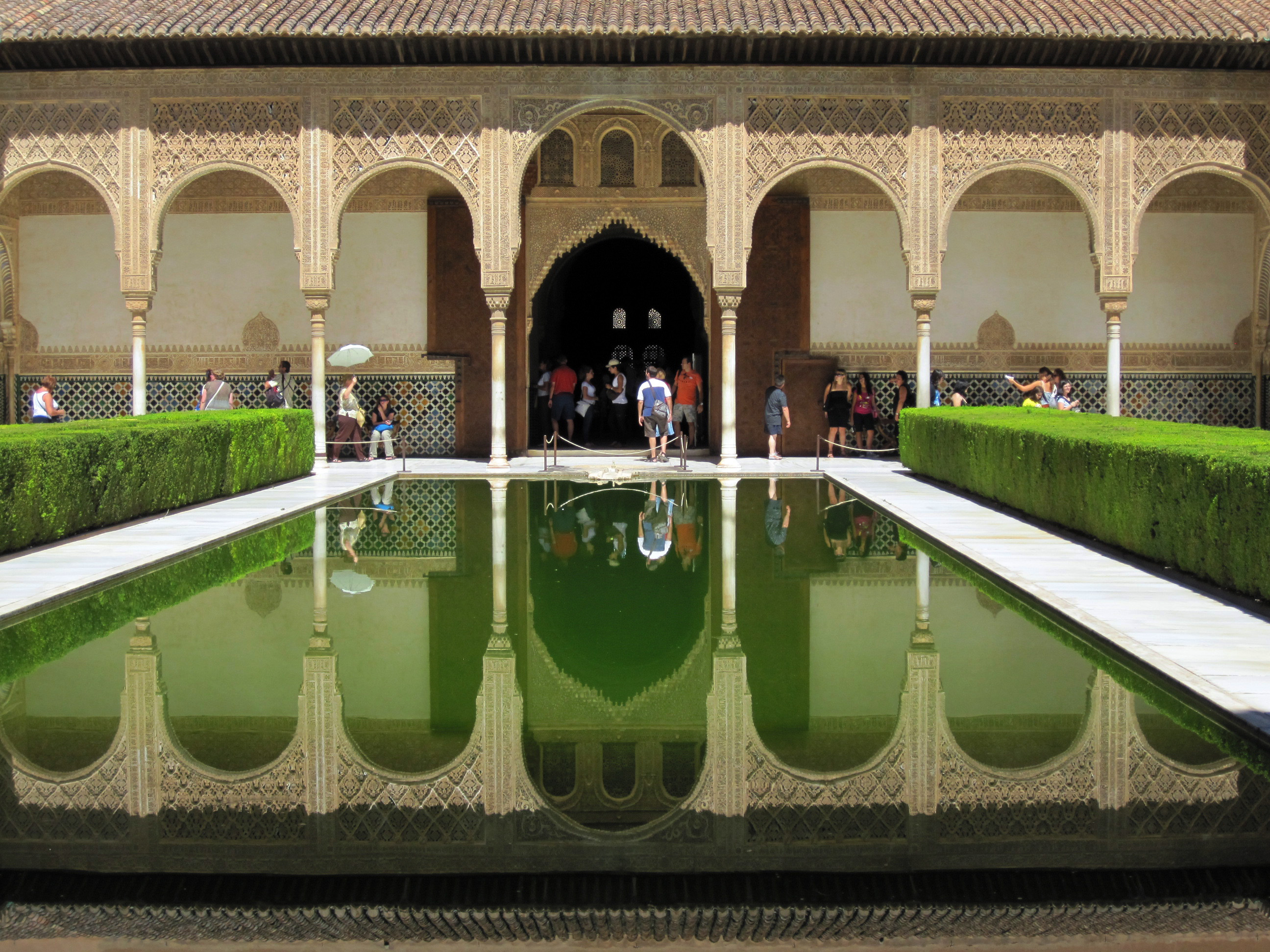 The Generalife has the beautiful gardens and the summer Palace of the Royal family. It’s only 8 minutes away by foot but it’s a lot cooler, probably because of the fountains and pools.
The Generalife has the beautiful gardens and the summer Palace of the Royal family. It’s only 8 minutes away by foot but it’s a lot cooler, probably because of the fountains and pools.
It’s a joy of landscape architecture and irrigation. Even the stone staircases have running water inside of the handrails. One of the courtyards is even named the “Courtyard of Joy” with fountains of water spraying mists over flower gardens. The views are fabulous, the air is sweet from jasmine and the walk back down to the town is much easier than the walk up.
Aside from the Alhambra and The Albaysin, Granada has a lot to offer in the newer/older town that built up around the grand Cathedral, The Cathedral of the Incarnation. The Spanish really loved building ginormous Grand Cathedrals. Most of them in this part of the country were built over Moorish Mosques. This one was no different.
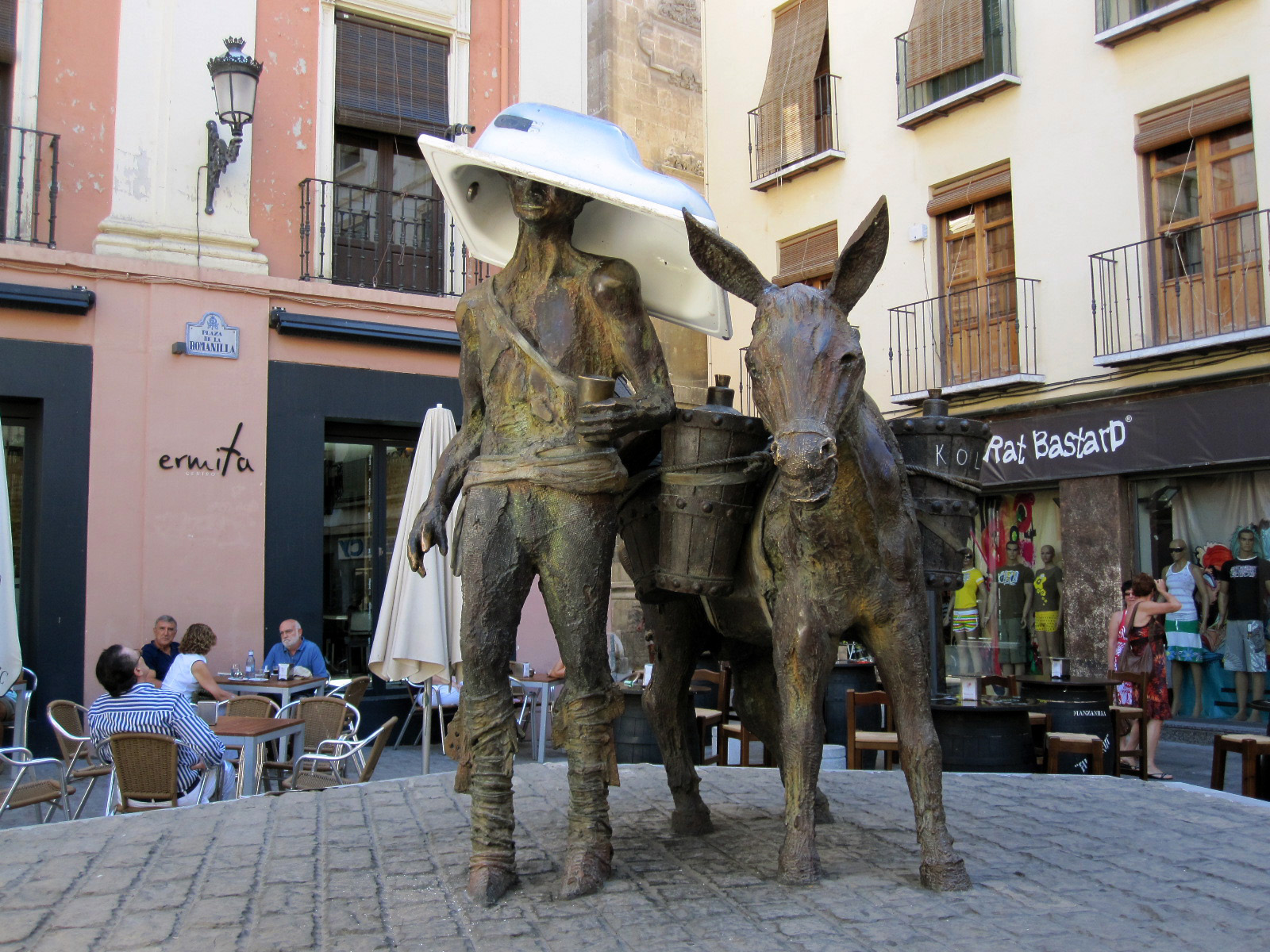 My favorite thing about The Granada Cathedral is that it’s centered amongst some really beautiful small squares, narrow streets, great little markets and lots of local Granada culture. Once you get past the gypsy women in front of the Cathedral entrance, offering you sprigs of rosemary as a gift you’ll find the quarter very relaxing and enjoyable. The sprigs of rosemary, by the way, are not a gift. If you take one, they will hound you for money. You’ll never be able to get away from them. Don’t accept it.
My favorite thing about The Granada Cathedral is that it’s centered amongst some really beautiful small squares, narrow streets, great little markets and lots of local Granada culture. Once you get past the gypsy women in front of the Cathedral entrance, offering you sprigs of rosemary as a gift you’ll find the quarter very relaxing and enjoyable. The sprigs of rosemary, by the way, are not a gift. If you take one, they will hound you for money. You’ll never be able to get away from them. Don’t accept it.
The Granada Cathedral is also interesting because it’s connected to the sacristy known as the Capilla Real which houses the crypt of Ferdinand and Isabella. The large Royal Tomb was built in the heavy ornate style now referred to as Isabellina Gothic. It’s a bizarre fundamentalist passion to these two, complete with their recumbent effigies in stone and their little lead coffins below. It’s huge and bizarre. However, when the Holy Roman Emperor, Charles V came into to see it, he thought it wasn’t big enough and wanted to muck it up even more, but he just didn’t have enough time. He was probably involving himself in ruining some other architectural treasure somewhere in Spain. Charles V reminds me of a lot of really bad scenic designers I’ve worked with in my life. Some people just like to muck it up.
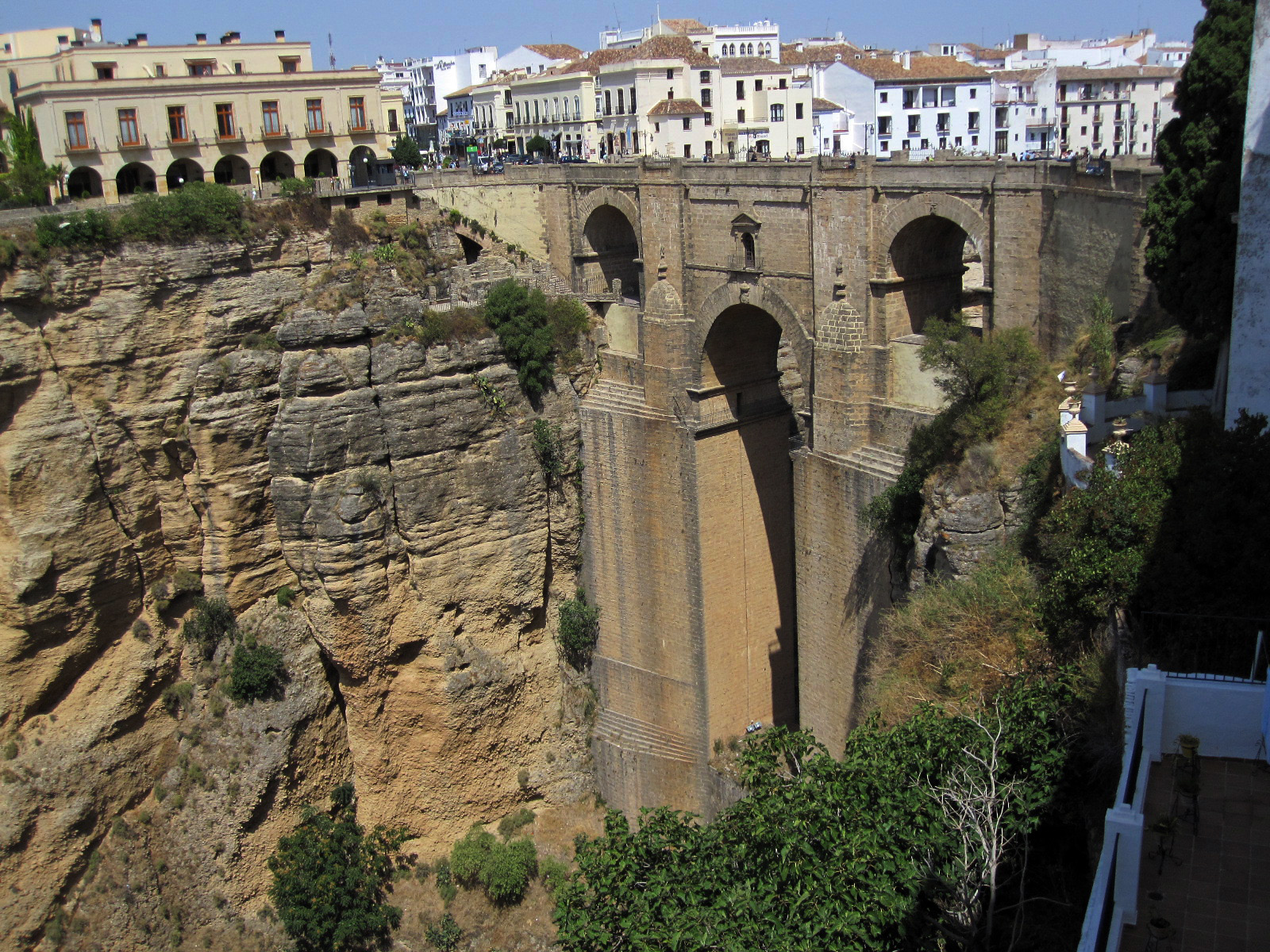 RONDA
RONDA
This small city high up in the Sierra de Grazalema Mountains has been one of the “look at me, Mom; top of the world” places for a long time.
From it’s position you can see for miles in any direction. It is the perfect place for a military stronghold or just a place to feel well protected. It was safe haven for prehistoric tribes. The Celts called it “Arunda”. The Phoenicians and Hittites had a short stay here but the Romans dispatched them pretty quickly. The Romans called it “Arunda Laus “the glorious”. The Moors built a magnificent city here called “Medina Runda” with lavish homes and splendid Mosques. But most of that was destroyed during the fierce battle against the armies of Ferdinand and Isabella. Anything left of the old city was finished off when Napoleon’s took the town 1806. If that wasn’t enough, during the Spanish Civil War, hundreds of bodies were tossed off the Puente Nuevo bridge into the gorge below.
The Puente Nuevo (one of Ronda’s endearing symbols) was built in 1740. The first version fell down. The second version with brick piers extending close to 300’ down into the gorge seems to be in good shape; cars and people cross it every day. We did too.
The weather patterns here are very weird. We checked into our hotel it was a hot day with not a breeze anywhere nearby. We settled into the room and took the computers out the terrace. WiFi was everywhere. A few minutes later the owner called our names to see if we wanted anything. We got up and went to meet her. Within seconds, a freak wind swooped in and blew Gretchen’s computer off the table. It was a pretty strong wind. The laptop weighed more than 5 pounds. After that, the air was once again still. It was almost as if the mountain gods hate technology.
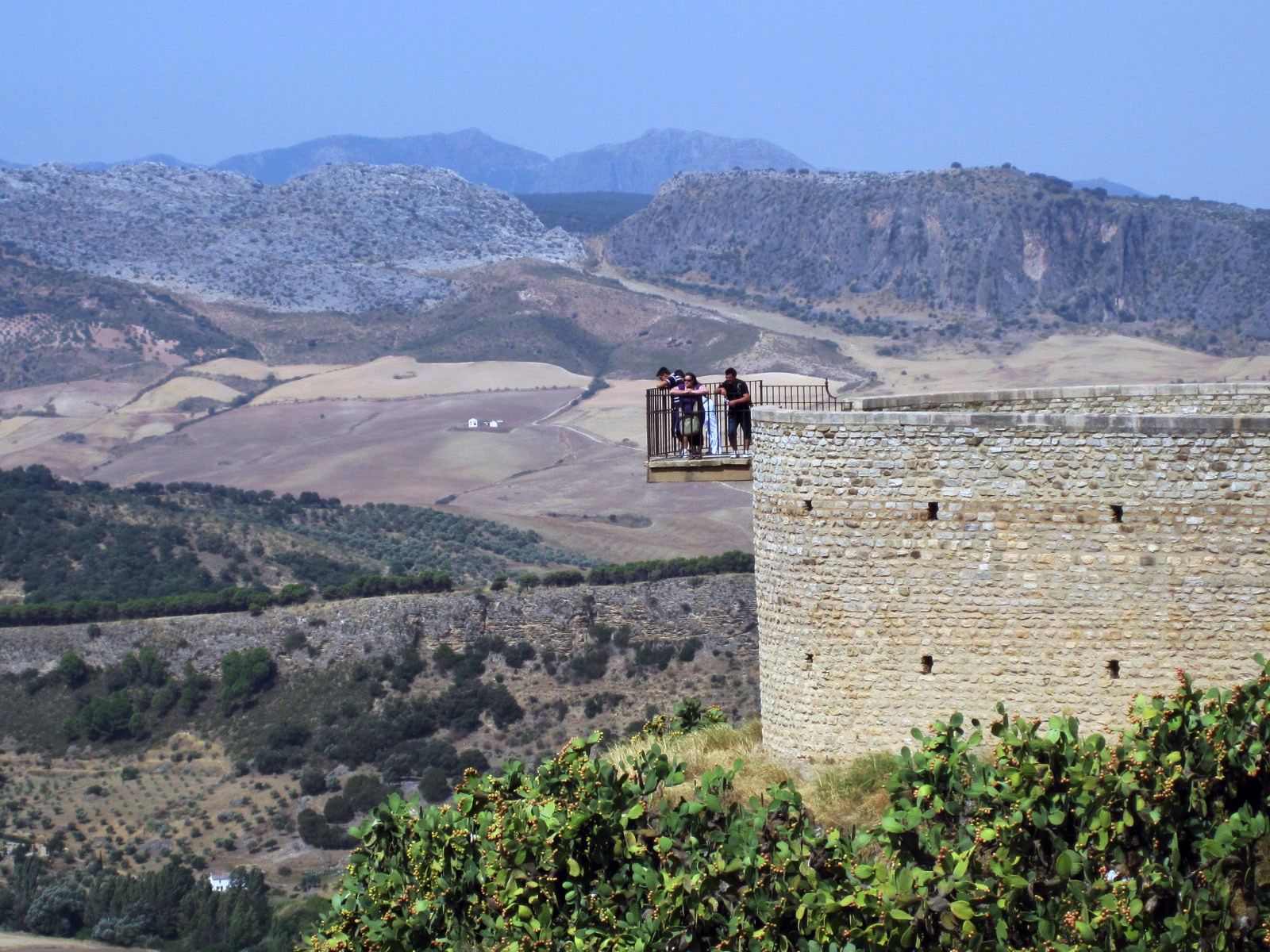 The next day, we were looking over the gorge and another freak wind blew Gretchen’s hat off her head. She got the hat but the sunglasses on her face blew an easy 1000’ feet down to the bottom of the gorge. Maybe the mountain gods are having their fun with Gretchen.
The next day, we were looking over the gorge and another freak wind blew Gretchen’s hat off her head. She got the hat but the sunglasses on her face blew an easy 1000’ feet down to the bottom of the gorge. Maybe the mountain gods are having their fun with Gretchen.
In the 18th century Ronda became the home of Spanish bullfighting. Bullfighting has been a tradition in Spain (and most of the known world) for a long time. The Sumerians, Hittites and Phoenicians have recorded records of bullfights. Bull sacrifices were common with the Ancient Greeks and Romans. The brave soldiers of Rome worshipped Mithras, who created the world of good and evil when he killed a bull.
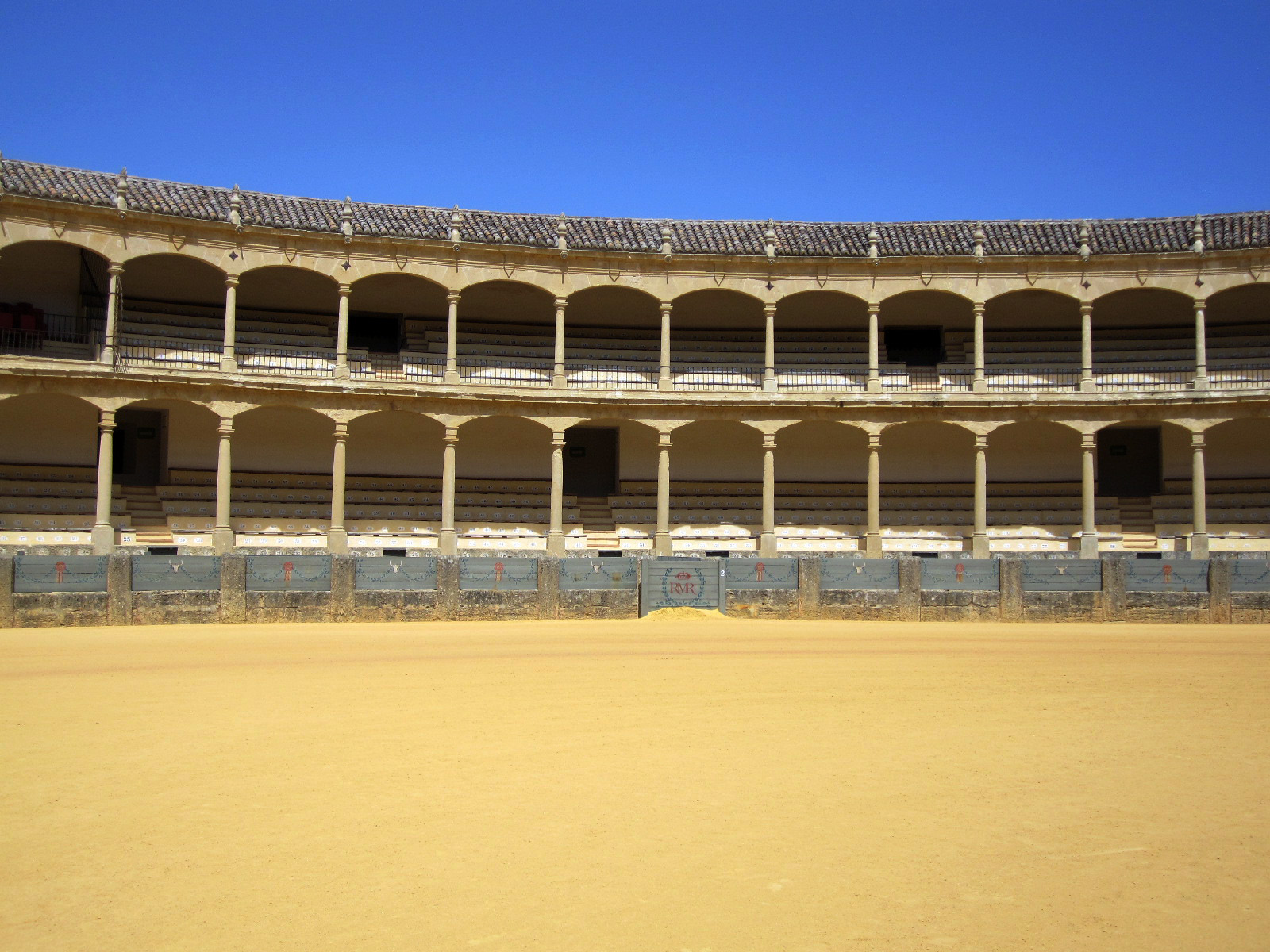 The sport was outlawed for a while by the Moors, but after the “Reconquista” of Spain, the tradition returned. In 1785, the Maestranza (the order of Knights ) was initiated in Ronda to guard the rules of the Corrida, the Bull fight.
The sport was outlawed for a while by the Moors, but after the “Reconquista” of Spain, the tradition returned. In 1785, the Maestranza (the order of Knights ) was initiated in Ronda to guard the rules of the Corrida, the Bull fight.
Some of the most famous bullfighting families have come from Ronda and their lineage is still dominating the game. The most famous is probably Antonio Ordóñez, who fought over 300 bulls and was a good friend of Ernest Hemingway and Orson Welles. When Welles died in 1985, his ashes were taken to Ronda and interred in an old well on the property of Antonio Ordóñez.
The 30 (something) Cayetano Rivera Ordóñez is the new hero of the bull ring. He is the grandson of Antonio Ordóñez. Cayetano is lean and handsome and has the celebrity status of a superstar. The owner of the hotel we’re staying at refers to Cayetano as the Brad Pitt of Spain.
A Corrida is pretty much defined as three toreadors fighting 2 bulls. The bulls are big, strong and weigh between 400-500kg (880-1200 lbs). The toreadors are small, fast and rarely weigh more than 150 lbs.
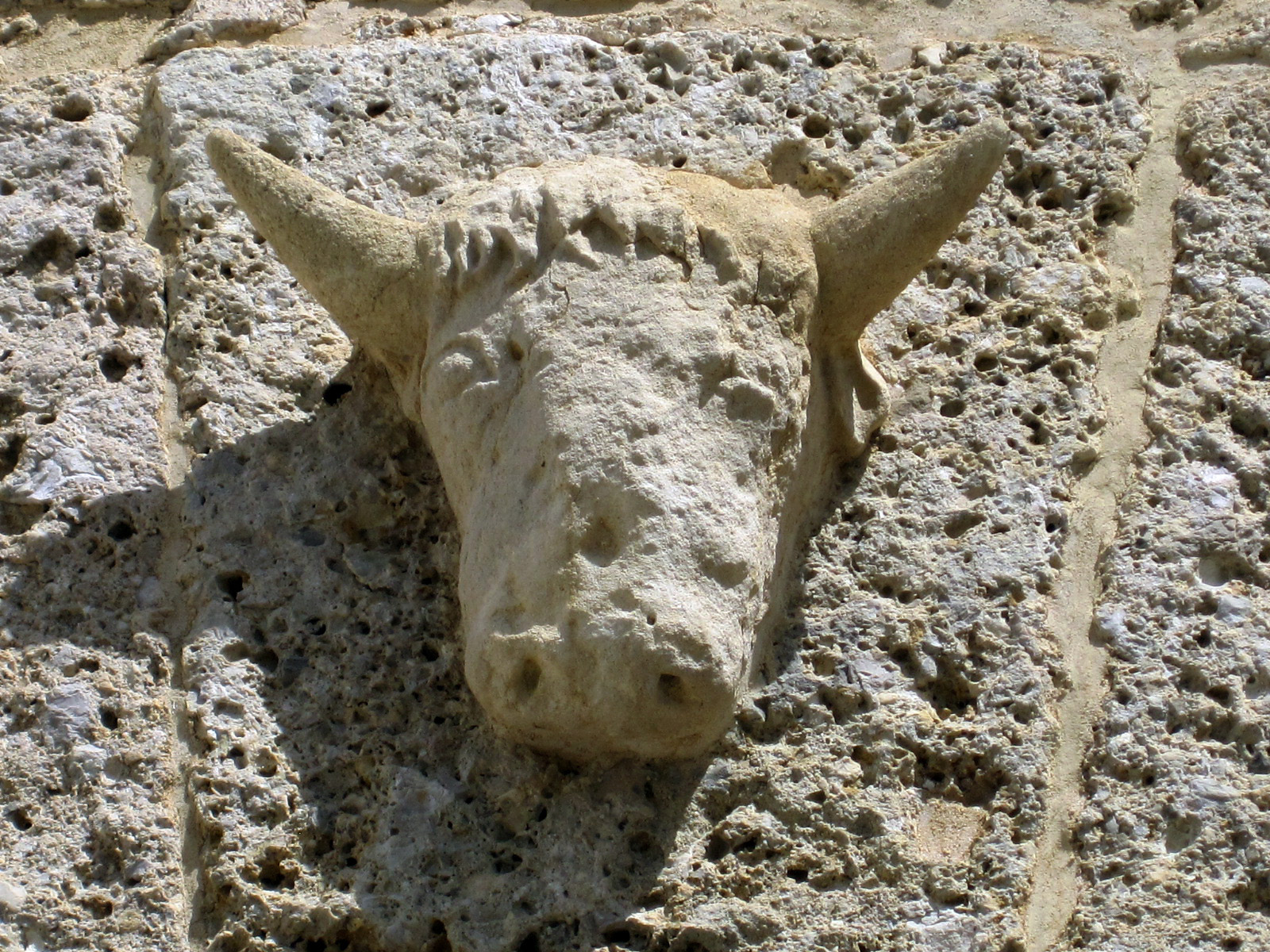 The fight is played out in three parts. 1st the toreador and the bull stare into each others eyes and check each other out. The toreador is graceful and regal. The bull is slightly pissed off because before the bull entered the ring, the picadors punctured and pinched the mound of flesh on his neck. It hurts and it’s starting to bleed.
The fight is played out in three parts. 1st the toreador and the bull stare into each others eyes and check each other out. The toreador is graceful and regal. The bull is slightly pissed off because before the bull entered the ring, the picadors punctured and pinched the mound of flesh on his neck. It hurts and it’s starting to bleed.
The second part of the fight introduces the Picadores who come in on horseback and stab the bull near the neck wound, trying to weaken the neck and piss him off even more. The crowd cheers. They want the bull to fight. They want him pissed off. No one wants to see a docile bull.
The third stage, the “Tercio de Banderillos is the final part. The banderilleros ride in on horseback and stab the bull with sharp spears in the side. Now the bull is really angry. The matador moves in and faces the bull with the muleta (a red cape). The bull is colorblind. The only reason the matador uses a red cape is used to mask the blood. No, the bull is not enraged by the color red. He is enraged because he has just been stabbed with a lot of spears.
The matador uses the muleta (cape) to pull the bull into a trancelike state, hypnotizing the beast with graceful waves of the cloth, guiding him from one side to the other, guiding the bull’s horns within inches of his small frame. Then, when he feels he has totally hypnotized the bull into his power, he lowers the muleta and brings the bull’s head down. This is the moment when he will deliver the “estocada”, thrusting the sword between the shoulders into the bull’s heart. The plight of the bull is usually the same, death. There are cases when the matador has so much respect for the beast, he spares his life. He pantomimes the estocada, but doesn’t kill the bull. Instead the big guy gets to spend the rest of his days fertilizing young cows and grazing in peaceful pastures. It’s is a bull’s dream but it doesn’t happen very often.
The Plaza del Toros de Ronda is the oldest (and possibly the most beautiful) in the world. At 216’ in diameter, it’s also the widest in the world. These days it’s also the widest Plaza de Toros museum in the world.
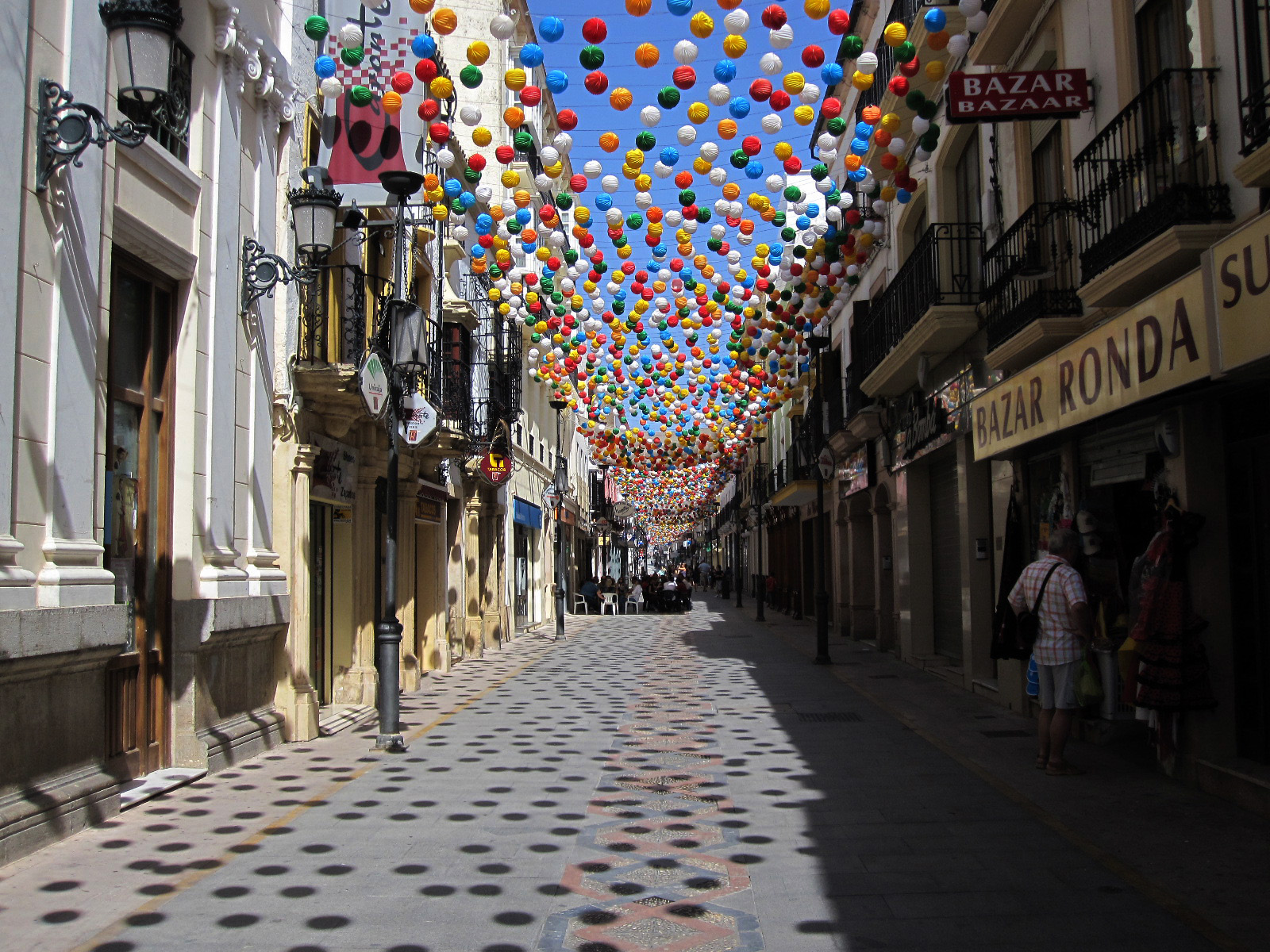 Plaza de Toros de Ronda hosts only one Corrida a year, every September, known as the “Corrida Goyesca”. The matadors dress in 18th century costumes right out of Goya painting. Tickets can go for up to €500 euros from scalpers. This is a once a year event and the town goes crazy. Every hotel room for miles is booked, which is why we came here the day after it was all over. And from the looks of it, it was some party. The street were covered with a canopy of colored lanterns that looked like balloons.
Plaza de Toros de Ronda hosts only one Corrida a year, every September, known as the “Corrida Goyesca”. The matadors dress in 18th century costumes right out of Goya painting. Tickets can go for up to €500 euros from scalpers. This is a once a year event and the town goes crazy. Every hotel room for miles is booked, which is why we came here the day after it was all over. And from the looks of it, it was some party. The street were covered with a canopy of colored lanterns that looked like balloons.
As the 19th century rolled in, Ronda maintained a reputation as a romantic destination. Europeans were going through a period of Romanticism, classical culture, poetry, literature, romance and bullfights. Spain captured a lot of imaginations. So did the Spanish Bandits who made a great reputation stopping coaches on their travels through Andalucia. Ronda provided them with a perfect “hideaway”. There is a museum dedicated to the bandits of 19th century Ronda. Someone is still cashing in.
There are some beautiful old houses that have been turned into museums. Some are from 15th century Spain, some have Moorish ruins and some have some pretty strange exhibits. The Palacio Mondragon included a series of “cheesy” lifesize prehistoric dioramas showing the people who once lived here a million years ago.
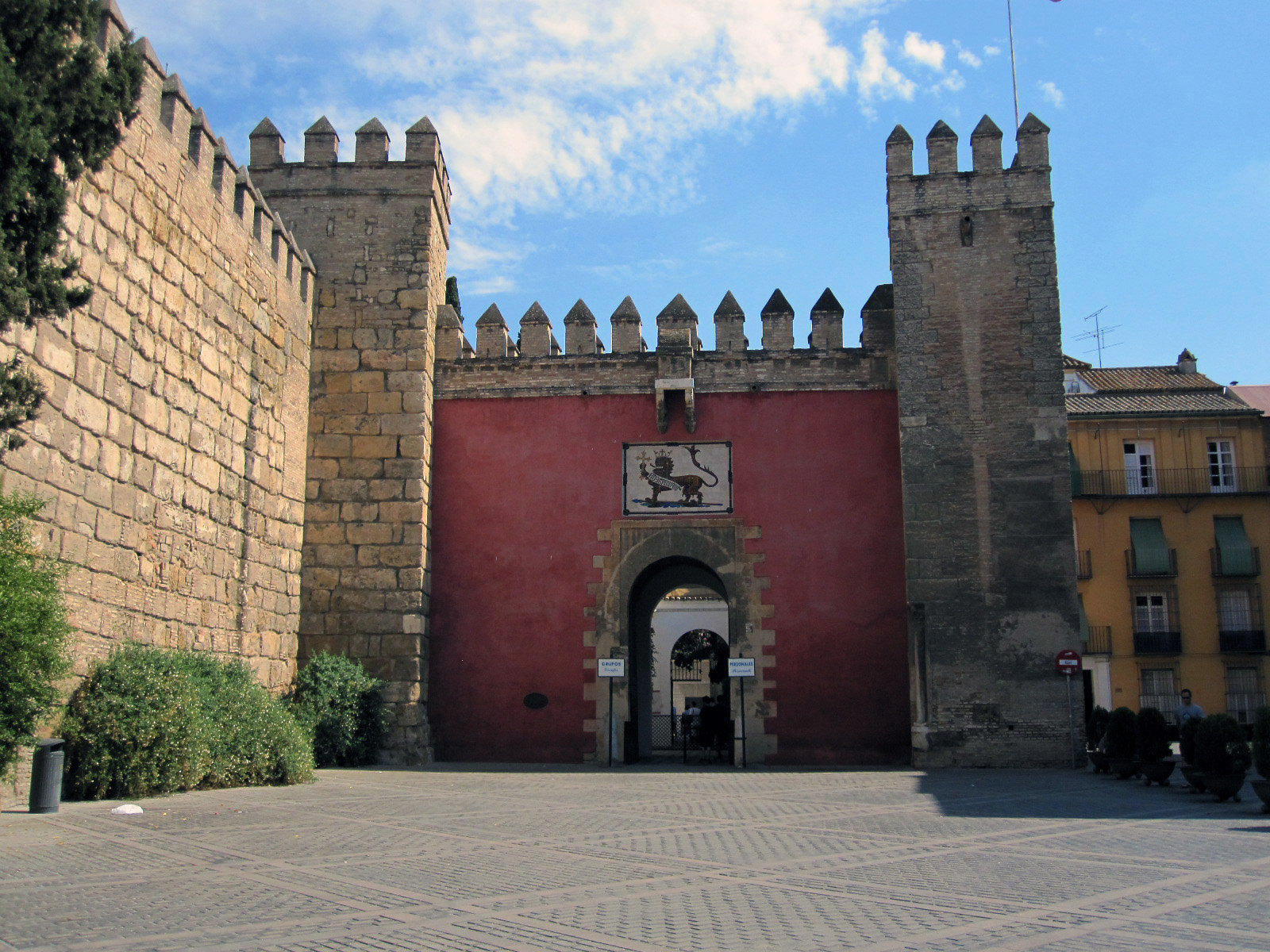 SEVILLE
SEVILLE
Seville was claimed by the Moors in 712 but it didn’t really become an important Moorish city until the 12th century when the Almohad Moors made it their capital.
There are still some remains of the Almohad thrown around, but they’re mostly hidden. The Giralda Tower (now the Church bell tower), the Torre del Oro and the Alcazar are the big three, but there are also hidden gems inside of some homes and restaurants around the old city. You just have to keep your eyes open and turn your head a lot.
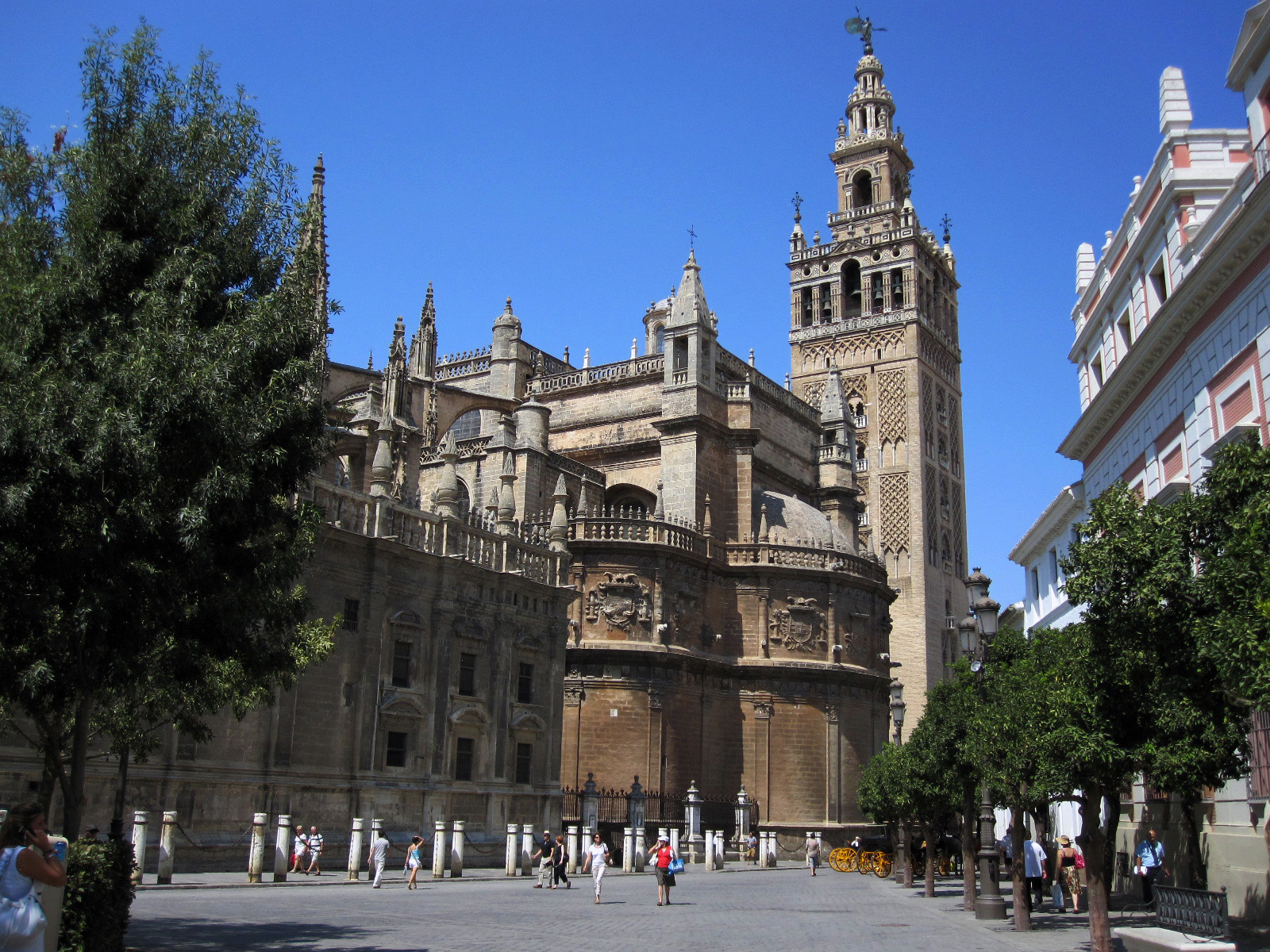 The original 365 ft tall minaret “La Giralda” was built by the Almohads in 1198.
The original 365 ft tall minaret “La Giralda” was built by the Almohads in 1198.
When Fernando III conquered the city in 1248, he rode his horse up the interior ramp to the top in a triumphant (and very theatrical) climb. It might have been a triumphant ride for Fernando, but probably not the fist time a man on horseback rode the ramp to the top. The Moorish Muezzin rode his donkey up the incline every day (actually a few times a day) to call the people to prayer. These days a miniature street sweeper is parked on the ground floor of the ramp and most likely makes the climb at the end of every day, cleaning up after the tourists.
At the top of La Giralda are the Bells of the Cathedral. And yes, they go off every hour. It’s really loud if you happen to be up there at the top of the hour.
The tower has been used as a model for many towers. In our hometown of San Francisco, the Ferry Building is designed after the Giralda.
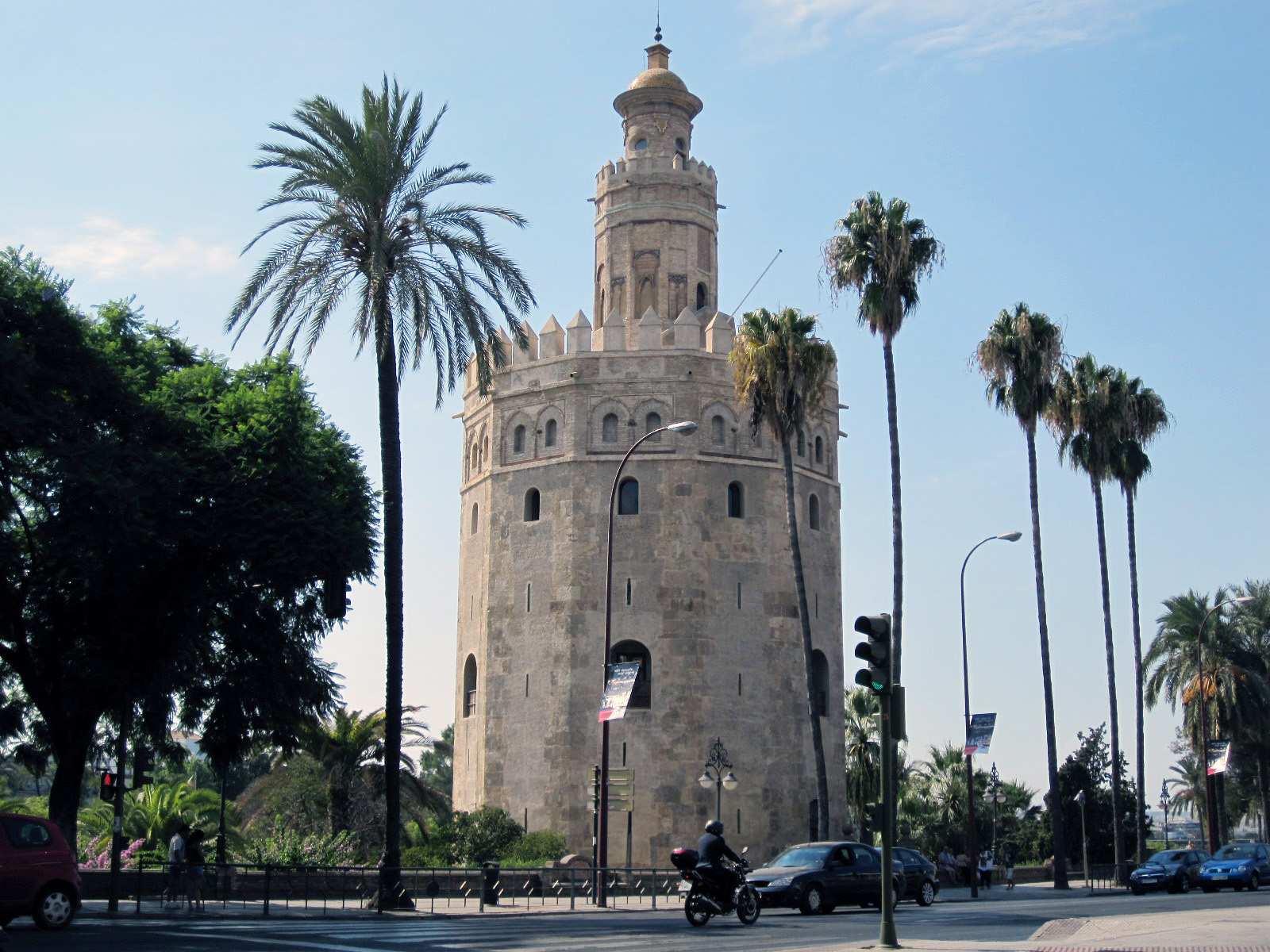 The Torre del Oro was originally used by the Almohad as a military watchtower across the Guadalquivir river. A large chain spanned the river to hold off any traffic. Some believe there was another (twin) tower on the other side of the river but there’s no proof of the claim.
The Torre del Oro was originally used by the Almohad as a military watchtower across the Guadalquivir river. A large chain spanned the river to hold off any traffic. Some believe there was another (twin) tower on the other side of the river but there’s no proof of the claim.
The tower was also used as prisons during the middle ages.
Fernando III, now known as Saint Ferdinand III, loved the city and although he decided to rebuild it, Christian style, he tried to incorporate as much of the old Moorish city as possible. He started with building a small Cathedral inside the walls of the Great Mosque. At this time the Mosque (finished by the Almohad in 1172) was less than a hundred years old.
The Mosque of Sevillia was probably around the same size as the one that still exists in Cordoba. However by 1356, the building suffered a lot of damage in an earthquake. Plans were drawn up for the new Cathedral. It took until 1402 to get the job started. It took till 1507, 95 years later to finish the job. Actually the job wasn’t finished until 1511. The largest Dome collapsed in the late 1400’s and had to be rebuilt. By the way, the same Dome collapsed a second time in 1888. Just mentioning it in case you plan on spending a lot of time under the dome.
The Church is enormous. It’s the third largest Church in the world next to St Peter’s in Rome and St. Paul’s in London. It’s the largest Gothic church in the world. Maybe it’s so big because the Mosque it was built over was so big, Maybe the Spanish just wanted to build the biggest church in the world. According to legend, the members of the building committee wrote: “Let a church so beautiful and so great that those who see it built will think we were mad”. I saw it and yes, I think they were mad.
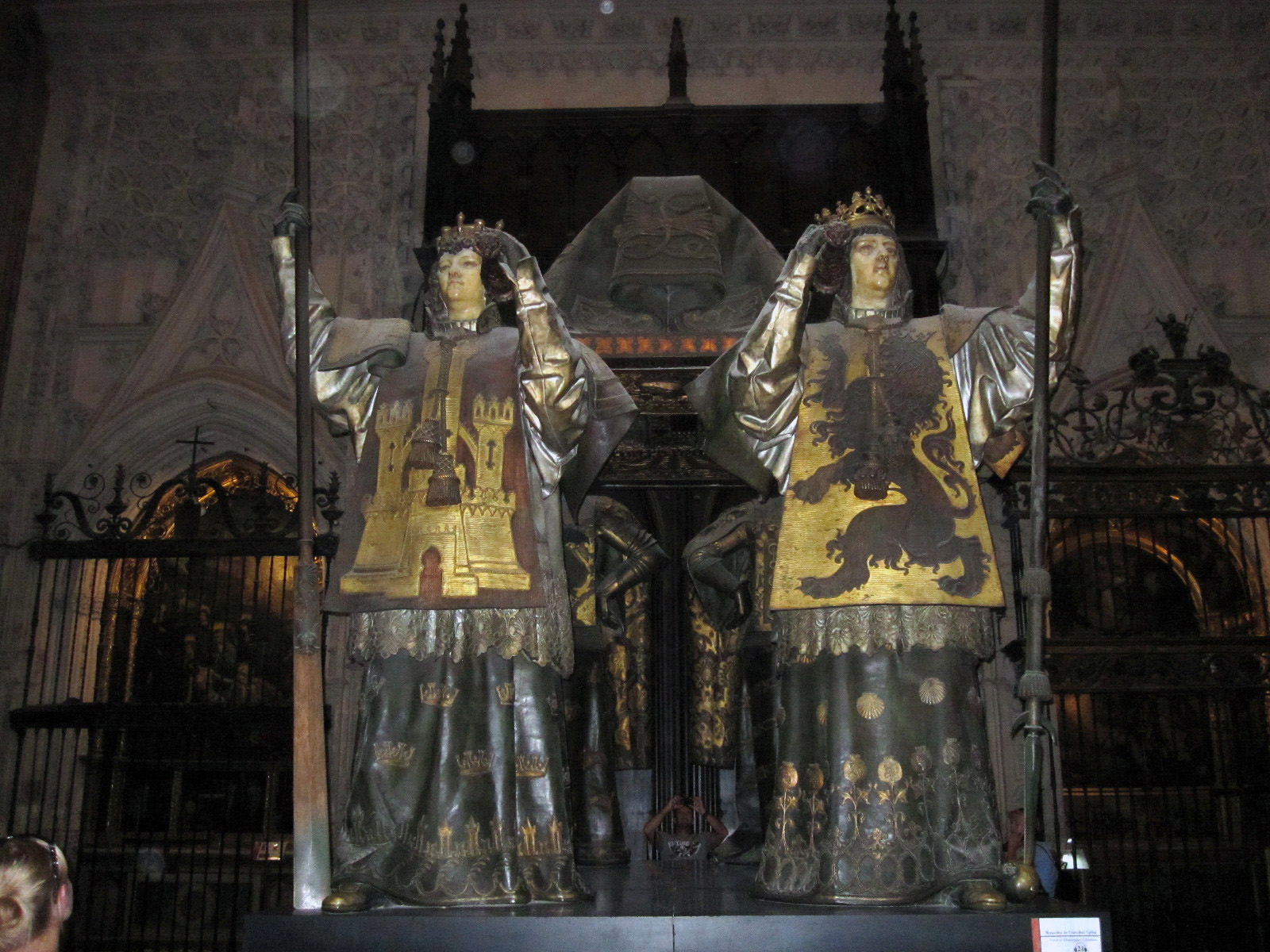 One of the most visited (and most crowded) places of the Cathedral is the Tomb of Christopher Columbus. The explorer was very integrated into the trade of Seville. His explorations were planned in this church and the wealth he brought back to Spain paid for the ornate décor.
One of the most visited (and most crowded) places of the Cathedral is the Tomb of Christopher Columbus. The explorer was very integrated into the trade of Seville. His explorations were planned in this church and the wealth he brought back to Spain paid for the ornate décor.
Columbus was given money to sail to India. Somehow he took a wrong turn and ended up in the Caribbean Ocean, no where near India. No matter though, as long as there was gold. The Spanish were crazy for gold and unfortunately almost wiped out a few civilizations in the process of bringing back to Spain.
The story of the remains of Christopher Columbus is almost as interesting as his life. He died in 1506 in Valladolid, Spain. In 1542, his son ordered the remains to be exhumed and transferred to Santo Domingo in eastern Hispaniola (now the Dominican Republic). In 1795, the French took over Santo Domingo and the Columbus remains were transferred to the safety of Spanish Havana, Cuba. They lounged around Havana for about 100 years till the Spanish American War when Cuba became an independent country.
In 1898, the remains of Christopher Columbus were sent to Seville and in 1902, whatever was left of them was put into the Tomb in the Cathedral.
However, to make the story a little more bizarre, in 1877, a lead box bearing an inscription “Don Cristóbal Colón” was found in Santo Domingo. Inside the box were bone fragments and a bullet . The people of Santo Domingo still believe this to be the real remains of Columbus.
 Another curious thing about the Cathedral, aside from the recumbent marble effigies and polychrome painted bronze statues, is the Gold (and silver). It’s an embarrassment of gold. It’s also an embarrassment of dust. By the looks of it, the Cathedral hasn’t been cleaned since 1507.
Another curious thing about the Cathedral, aside from the recumbent marble effigies and polychrome painted bronze statues, is the Gold (and silver). It’s an embarrassment of gold. It’s also an embarrassment of dust. By the looks of it, the Cathedral hasn’t been cleaned since 1507.
There is such a dullness in the ambience, you almost like you’re entering a cave. Even with all the gold and silver (did I tell you how much gold and silver is in this place) it’s dark and heavy and depressing.
During the ‘trade” years with the Americas (around 1503 -1649) Seville prospered. The population exploded to around 150,000 and money was flowing into all kinds of Church and Municipal buildings. Don Quixote was born here during this time, or Cervantes invented him while he was a guest in Seville’s debtor’s prison.
However, the Sevillianos of the 16th and 17th centuries were more showy than smart. Whatever came in, they spent. What was the use of having all the wealth if you couldn’t impress the rest of the world with it. They never saved anything. In 1649, along came the plague and there went ½ the city. Seville didn’t recover till the 1800’s.
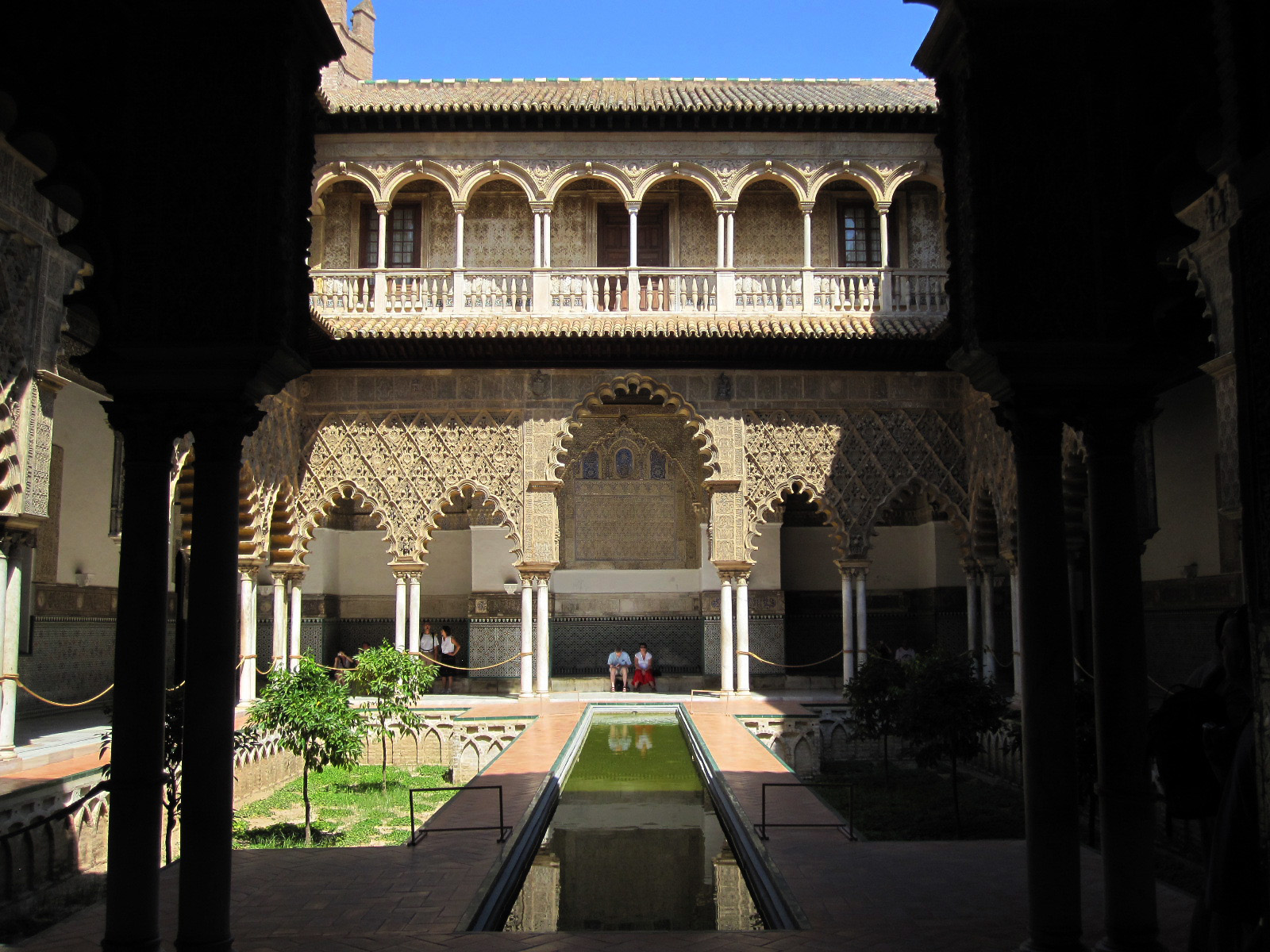 What began as a Almohad noble house, eventually became the Alcazar, the city’s Palace fortress. The construction started in 1181 but it took over 500 years to finish it. When Pedro the Cruel took possession of the building in the 1350’s he hired Almohad craftsmen still living in the area to build his palace in mudejar style. It was built during the time of the Moors and built by the Moors, but it wasn’t built for the Moors. It was built for a Christian King. Nonetheless, it’s a great example of 13th and 14th century mudejar architecture.
What began as a Almohad noble house, eventually became the Alcazar, the city’s Palace fortress. The construction started in 1181 but it took over 500 years to finish it. When Pedro the Cruel took possession of the building in the 1350’s he hired Almohad craftsmen still living in the area to build his palace in mudejar style. It was built during the time of the Moors and built by the Moors, but it wasn’t built for the Moors. It was built for a Christian King. Nonetheless, it’s a great example of 13th and 14th century mudejar architecture.
Pedro identified with the Moors. He loved to lounge around and hear poetry and he loved the passion of many women (usually when he was piss ass drunk). He was called Pedro the Just by the people he governed. The liked him a lot. “The Cruel” title came from the nobles and family who fought against him.
The Sala de la Justicia (Hall of Justice) in the Alcazar is where Pedro sentenced his brother to death for having an affair a wife he had abandoned. Just or Cruel? Pedro enjoyed life in the Alcazar for just a few years. He was killed in 1369. There are lots of great stories about this guy, but I’ll get into them the next time we come back to Seville.
The most impressive courtyard of the Alcazar is the Patio de las Doncellas (Courtyard of the Maidens). There is a story that 100 virgins were sent here by the Christian Kings for the pleasure of the Moors. It’s probably just a story. The courtyard was actually built by Pedro the Cruel, although he just might have received 100 virgins here. He was known to have some pretty wild parties in the Salon of the Embajadores (The Hall of the Ambassadors), just off the maidens court. The Courtyard of the Maidens was recently used for the Court of the King of Jerusalem in the Ridley Scott film the “Kingdom of Heaven”.
The Alcazar is a treasure of tile and plaster but it’s dreamlike quality abruptly ends when you walk into the wing built by Charles V. You might remember the Holy Roman Emperor Carlo V as the King who mucked up the Alhambra. Well, here he is again, sticking his Hapsburg chin into another mess of mudejar and gothic (two styles that just don’t go well together). The Lisbon earthquake in 1753 cracked a lot of the tiles from the Charles V wing. Luckily the rest of the Alcazar did fine.
I didn’t shave for about 4 days prior to coming to Seville. I dragged Gretchen around the city for about 3 hrs looking for a barber. I really wanted to write that I got a shave from the Barber of Seville. But it never happened. There are a lot of hair salons where I was offered a trendy haircut, but none of them knew a good old fashion barber.They thought I was nuts. Disposable razors have eliminated a very honored profession.
There is so much more to Seville that we’ll have to save for next time. In the Maria Luisa Park is the Plaza de Espana , a 1920’s revival of mudejar architecture built for the 1929 Spanish American Exposition. The fair was a flop and almost bankrupted the city, but the building was used as the Cairo British Army HQ in the David Lean film “Lawrence of Arabia”. The La Maestranza (the bullfight ring) is supposed to have the best acoustics of all the Plaza del Toros in Spain. Supposedly you can hear the snap of the matador’s cape. It’s also the Plaza de toros where Bizet set his opera Carmen. Her statue stands outside of the arena. There more. We’ll be back for sure.
You must be logged in to post a comment.